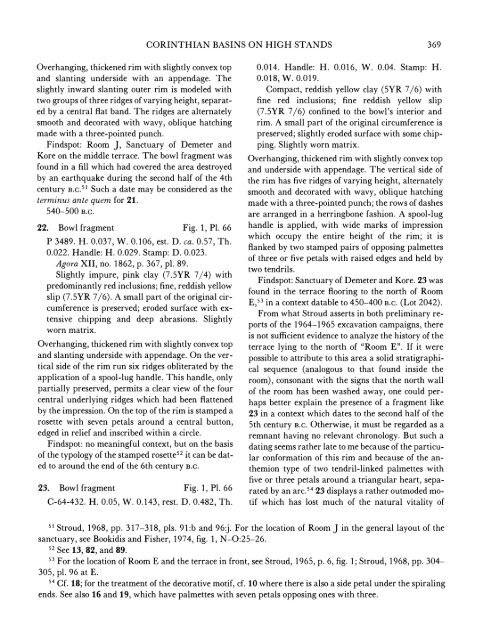f - The American School of Classical Studies at Athens
f - The American School of Classical Studies at Athens
f - The American School of Classical Studies at Athens
You also want an ePaper? Increase the reach of your titles
YUMPU automatically turns print PDFs into web optimized ePapers that Google loves.
Overhanging, thickened rim with slightly convex top<br />
and slanting underside with an appendage. <strong>The</strong><br />
slightly inward slanting outer rim is modeled with<br />
two groups <strong>of</strong> three ridges <strong>of</strong> varying height, separ<strong>at</strong>-<br />
ed by a central fl<strong>at</strong> band. <strong>The</strong> ridges are altern<strong>at</strong>ely<br />
smooth and decor<strong>at</strong>ed with wavy, oblique h<strong>at</strong>ching<br />
made with a three-pointed punch.<br />
Findspot: Room J, Sanctuary <strong>of</strong> Demeter and<br />
Kore on the middle terrace. <strong>The</strong> bowl fragment was<br />
found in a fill which had covered the area destroyed<br />
by an earthquake during the second half <strong>of</strong> the 4th<br />
century B.C.5" Such a d<strong>at</strong>e may be considered as the<br />
terminus ante quem for 21.<br />
540-500 B.C.<br />
22. Bowl fragment Fig. 1, P1. 66<br />
P 3489. H. 0.037, W. 0.106, est. D. ca. 0.57, Th.<br />
0.022. Handle: H. 0.029. Stamp: D. 0.023.<br />
Agora XII, no. 1862, p. 367, pl. 89.<br />
Slightly impure, pink clay (7.5YR 7/4) with<br />
predominantly red inclusions; fine, reddish yellow<br />
slip (7.5YR 7/6). A small part <strong>of</strong> the original cir-<br />
cumference is preserved; eroded surface with ex-<br />
tensive chipping and deep abrasions. Slightly<br />
worn m<strong>at</strong>rix.<br />
Overhanging, thickened rim with slightly convex top<br />
and slanting underside with appendage. On the vertical<br />
side <strong>of</strong> the rim run six ridges obliter<strong>at</strong>ed by the<br />
applic<strong>at</strong>ion <strong>of</strong> a spool-lug handle. This handle, only<br />
partially preserved, permits a clear view <strong>of</strong> the four<br />
central underlying ridges which had been fl<strong>at</strong>tened<br />
by the impression. On the top <strong>of</strong> the rim is stamped a<br />
rosette with seven petals around a central button,<br />
edged in relief and inscribed within a circle.<br />
Findspot: no meaningful context, but on the basis<br />
<strong>of</strong> the typology <strong>of</strong> the stamped rosette52 it can be d<strong>at</strong>ed<br />
to around the end <strong>of</strong> the 6th century B.C.<br />
23. Bowl fragment Fig. 1, P1. 66<br />
C-64-432. H. 0.05, W. 0.143, rest. D. 0.482, Th.<br />
CORINTHIAN BASINS ON HIGH STANDS 369<br />
0.014. Handle: H. 0.016, W. 0.04. Stamp: H.<br />
0.018, W. 0.019.<br />
Compact, reddish yellow clay (5YR 7/6) with<br />
fine red inclusions; fine reddish yellow slip<br />
(7.5YR 7/6) confined to the bowl's interior and<br />
rim. A small part <strong>of</strong> the original circumference is<br />
preserved; slightly eroded surface with some chipping.<br />
Slightly worn m<strong>at</strong>rix.<br />
Overhanging, thickened rim with slightly convex top<br />
and underside with appendage. <strong>The</strong> vertical side <strong>of</strong><br />
the rim has five ridges <strong>of</strong> varying height, altern<strong>at</strong>ely<br />
smooth and decor<strong>at</strong>ed with wavy, oblique h<strong>at</strong>ching<br />
made with a three-pointed punch; the rows <strong>of</strong> dashes<br />
are arranged in a herringbone fashion. A spool-lug<br />
handle is applied, with wide marks <strong>of</strong> impression<br />
which occupy the entire height <strong>of</strong> the rim; it is<br />
flanked by two stamped pairs <strong>of</strong> opposing palmettes<br />
<strong>of</strong> three or five petals with raised edges and held by<br />
two tendrils.<br />
Findspot: Sanctuary <strong>of</strong> Demeter and Kore. 23 was<br />
found in the terrace flooring to the north <strong>of</strong> Room<br />
E,53 in a context d<strong>at</strong>able to 450-400 B.C. (Lot 2042).<br />
From wh<strong>at</strong> Stroud asserts in both preliminary re-<br />
ports <strong>of</strong> the 1964-1965 excav<strong>at</strong>ion campaigns, there<br />
is not sufficient evidence to analyze the history <strong>of</strong> the<br />
terrace lying to the north <strong>of</strong> "Room E". If it were<br />
possible to <strong>at</strong>tribute to this area a solid str<strong>at</strong>igraphi-<br />
cal sequence (analogous to th<strong>at</strong> found inside the<br />
room), consonant with the signs th<strong>at</strong> the north wall<br />
<strong>of</strong> the room has been washed away, one could per-<br />
haps better explain the presence <strong>of</strong> a fragment like<br />
23 in a context which d<strong>at</strong>es to the second half <strong>of</strong> the<br />
5th century B.C. Otherwise, it must be regarded as a<br />
remnant having no relevant chronology. But such a<br />
d<strong>at</strong>ing seems r<strong>at</strong>her l<strong>at</strong>e to me because <strong>of</strong> the particu-<br />
lar conform<strong>at</strong>ion <strong>of</strong> this rim and because <strong>of</strong> the an-<br />
themion type <strong>of</strong> two tendril-linked palmettes with<br />
five or three petals around a triangular heart, sepa-<br />
r<strong>at</strong>ed by an arc.54 23 displays a r<strong>at</strong>her outmoded mo-<br />
tif which has lost much <strong>of</strong> the n<strong>at</strong>ural vitality <strong>of</strong><br />
51 Stroud, 1968, pp. 317-318, pls. 91:b and 96:j. For the loc<strong>at</strong>ion <strong>of</strong> Room J in the general layout <strong>of</strong> the<br />
sanctuary, see Bookidis and Fisher, 1974, fig. 1, N-0:25-26.<br />
52 See 13, 82, and 89.<br />
53 For the loc<strong>at</strong>ion <strong>of</strong> Room E and the terrace in front, see Stroud, 1965, p. 6, fig. 1; Stroud, 1968, pp. 304-<br />
305, pl. 96 <strong>at</strong> E.<br />
54 Cf. 18; for the tre<strong>at</strong>ment <strong>of</strong> the decor<strong>at</strong>ive motif, cf. 10 where there is also a side petal under the spiraling<br />
ends. See also 16 and 19, which have palmettes with seven petals opposing ones with three.

















